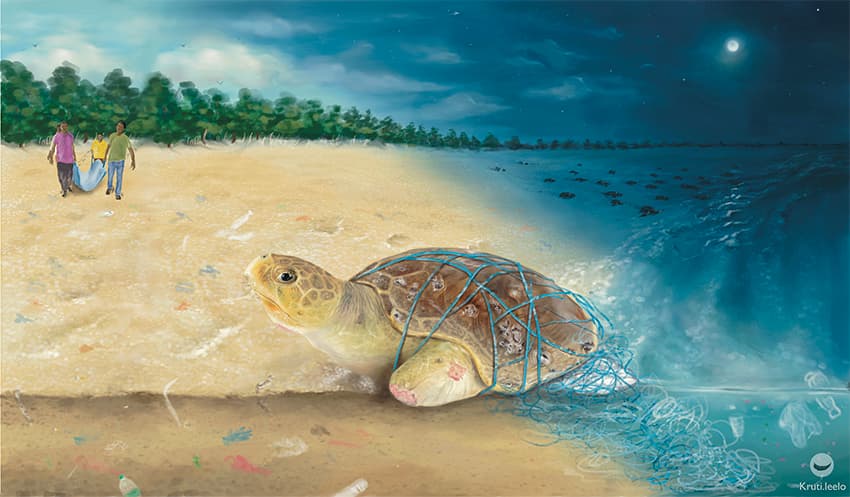I could smell the salty sea in her heavy breath, filled with exhaustion and the quiet pain of giving up. A full-grown Olive Ridley sea turtle, she was washed ashore a beach in Dahanu, a seaside town over a hundred kilometres north of Mumbai, with three of her four flippers missing.

Illustration: Kruti Patel
Monsoon, on the west coast of India, is also the season of strandings, when choppy seas wash these Late Jurassic era reptiles ashore on tar ball and plastic covered beaches. Hit by boat propellers, trapped in tangles of ‘ghost’ nets, flippers severed, bleeding, these sea turtles are the amputees of the Anthropocene.
After watching palm-sized Olive Ridley hatchlings make determined strides towards the sea, on the nesting beach of Velas, in the Ratnagiri district of Maharashtra, I had wished to see an adult – a nesting female. Driven by that quest, I patrolled the moonlit beach for two nights, sinking my shoes in sand, till my thighs began to ache. A few months later, I finally beheld my first Olive Ridley adults – a pair – in a tiled cement-tank inside a sea turtle treatment centre in Dahanu. One had lost 80 percent of its front left flipper; another’s front left flipper was badly mutilated, and dangled from a tendon. Yet, the duo showed marvellous resilience, paddling along the edges of the tank. Both were victims of ghost nets – fishing nets discarded, abandoned or lost at sea, that trap, injure and kill countless sharks, rays, turtles, dolphins, whales, seals, crabs, and seabirds.
The dangling flipper had to be amputated soon after, I learnt on my next visit, when I saw another amputee up close: the female that had lost three flippers, and all chances of ever going back to sea. Caregivers would lug her out of her quarantine tank every day, lay her on the operating table, and clean and treat her carapace, which was pockmarked with deep wounds.
A few young men, passionate wildlife rescuers all, had been trained in handling, restraining, caring, hand- and tube-feeding, administering external medication, stool sample collection, and much more, by Dr. Dinesh Vinherkar, a veterinarian who treats the fanciest pet breeds in Mumbai’s western suburbs on weekdays, and rushes to the sea turtles in Dahanu on weekends. The veterinarian, and the passionate volunteers trained by him, were all part of the Wildlife Conservation and Animal Welfare Association, a non-profit founded by Dhaval Kansara, the spirited wildlife warden of the Palghar district, which helped the Dahanu Forest Division run the treatment centre.
The deep wounds on the carapaces of stranded turtles are part of a vicious cycle. Battered by boat hits, maimed by their propellers, these turtle lose their bearings. Ghost nets, floating at various depths of the sea, trap them, and sometimes, drown them. Debilitated turtles get excessively covered with barnacles (a group of non-mobile crustaceans that attach themselves to rocks, ships, whales and turtles), and attacked by other parasites, making them vulnerable to more life-threatening infections.
Sea turtles have evolved to be resilient. For the tiny hatchlings, life begins in the dark egg chamber, under the sand. Here, they work as a team to dig themselves out. The entire clutch emerges together, or in smaller batches, to overwhelm predators like crabs, crows, gulls and dogs waiting for an easy meal on the sandy beach. Only those that survive this first hurdle make it to the sea, where marine predators await. If they survive this stage, and grow in size, they have fewer predators to worry about: larger sharks and killer whales. They have been dodging these natural threats for millions of years. But the dawn of the Anthropocene has brought with it newer, deadlier threats: millions of tons of plastic; destruction of beaches; trawl-nets that trap and drown turtles; neon-lights that shine brighter than the moon, disorienting hatchlings away from the ocean; and industrial boat-propellers that slice turtle flippers into two, and sometimes even crack the carapaces of adult turtles. Current estimates suggest that now only 1 in 1,000 to 10,000 sea turtles reach breeding age.
Looking into the weary, watery eye of the one-flippered amputee, I felt a pang of guilt. Instead of looking away, I peered deeper into her pupil, and my mind wandered to the Velas beach. Baby turtles were making little strides towards the sea, under the watchful eyes of village volunteers who safeguarded their nests in a fenced hatchery. After getting their first wash by a mild wave, they wiped the sand off their eyes with their tiny flippers, and plodded along. As the next massive wave took two of them into the embrace of the sea, a little girl in a green frock, trying to jump out of her father’s arms, squealed with delight. The daydream was over, and I was back in Dahanu. Could the little girl’s laughter be an omen of hope? Can we change our ways, make amends, and reconcile our relationship with fellow species? I wondered, as the volunteers lifted the struggling amputee turtle from the operation table, and lowered her back into the gloomy quarantine tank.
——————————————————————————————————————————————————————
About the Author: Rizwan Mithawala is a Conservation Writer with the Wildlife Conservation Trust and a Fellow of the International League of Conservation Writers.
About the Illustrator: Natural history and conservation illustrator Kruti Patel seeks to invoke a reverence for nature, and inspire action to defend it.
Disclaimer: The author is associated with Wildlife Conservation Trust. The views and opinions expressed in the article are his own and do not necessarily reflect the views and opinions of Wildlife Conservation Trust.
——————————————————————————————————————————————————————
Your donations support our on-ground operations, helping us meet our conservation goals.
——————————————————————————————————————————————————————
Related Links
- Eurasian Otters – Lost and Found
- Ecological Connectivity in the Age of Economic Corridors
- Livestock Loss Due to Wolves
- Team
- Careers
- Poaching and trade of jackals rampant: Study

